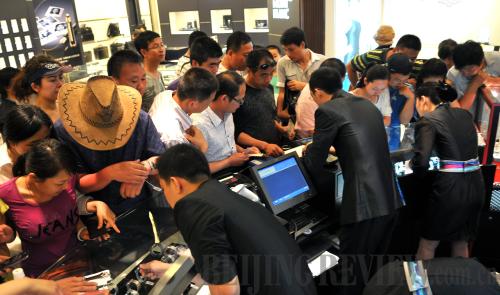|
 |
|
DUTY-FREE FRENZY: Tourists at Sanya, Hainan Province, look at and try on watches at a duty-free store. Tariff cuts on luxury imports could affect luxury sales in the province (HOU JIANSEN) |
To avoid these taxes, Chinese customers buy luxury items worth nearly 200 billion yuan ($30.77 billion) in overseas markets, he said.
In France alone, Chinese tourists bought duty-free goods worth 650 million euros ($934.2 million) last year and were reelected the "Shopping King of France," said a May report by Global Blue Group, a Switzerland-based tax-refund and shopping service provider.
As a direct result of the price gaps, domestic purchases account for less than 20 percent of Chinese customers' luxury spending during the February-March period, according to statistics from Beijing-based World Luxury Association.
Financial data of the world's second largest luxury group, Switzerland-based Richemont, said Chinese shoppers contributed to 40 percent of its global sales, half of which were identified as overseas purchases.
Some Chinese splurge on fancy goods while traveling, but others choose purchasing agent services. These agents, who usually have many chances to travel abroad, will buy luxury products overseas for them at prices lower than domestic prices. The Chinese spent 12 billion yuan ($1.8 billion) on these services last year, mostly on cosmetics and luxury goods, which alone equals to a tax loss of several billion yuan (several hundred million dollars) for China, if measured by an import duty of 40 percent, said statistics from a report on China's e-commerce market in 2010 by the China Internet Information Center. This doesn't include the huge amount of money spent on direct purchases by Chinese tourists.
The huge tax loss makes it urgent for China to slash import duties on luxury goods.
"China will address the price gaps for some high-end imported products and such moves will directly turn China's luxury spending overseas into domestic demand, a key solution to the fact domestic consumption is only a third of China's total luxury spending worldwide," said Chen Deming, Minister of Commerce.
Interests diverge
MOFCOM's announcement on luxury import duty cuts has stirred the imagination for affordable luxury brands with more choices at home, but denial from the MOF soon quenched that wild anticipation.
According to the 21st Century Economic Herald report, MOFCOM submitted a proposal for adjusting luxury import duties to the State Council a year ago, involving cosmetics, jewelry, clothes and high-end watches, but the proposal covered too many items and demanded coordination between many ministries. This issue has remained unresolved between these ministries for months.
"Different ministries have different interests," said Zhang Xiaoji, a researcher with the Development Research Center of the State Council. "The MOF is concerned about decreases in its tax revenues while the MOFCOM—responsible for commerce, consumption and distribution—hopes to boost domestic spending and help domestic enterprises importing raw materials and equipment to cut production costs by slashing tariffs."
Imported goods generated nearly 1.05 trillion yuan ($161.5 billion) in value-added and consumption taxes, and 202.7 billion yuan ($31.2 billion) in tariffs last year, which stands at 29.5 percent of China's central fiscal revenues, said MOF statistics.
In addition, it could be too complicated to figure out an appropriate extent of tariff cuts: The amount of potential overseas spending that will therefore become domestic, and whether tax revenue increases from such spending can offset losses from importing them at lower tariffs.
And whether tariff cuts will yield desired effects also hinges on free competition between importers of luxury goods, as only a few licensed importers are allowed to import and supply the domestic market with luxury goods. As it stands, these tariff cuts could end up becoming revenue increments for monopolistic suppliers who will not necessarily cut prices accordingly, said a recent 21st Century Economic Herald editorial.
Tariff cuts are also a double-edge sword. Cuts have the potential to suffocate China's nascent luxury brands, while encouraging domestic consumption of luxury brand-name products. "If imported goods are cheap enough to make domestic customers give up domestic brands, it could erode the profitability of domestic manufacturers," Wang said.
But domestic prices of imported cosmetics are unlikely to decrease promptly even if the tariff rate were dropped to zero, said a report on Chinese's luxury spending by the Boston Consulting Group. China imposes a variety of taxes on imported cosmetics products. Lipsticks, for example, are subject to a 10-percent import duty, 17-percent value-added tax and 30-percent consumption tax. The final price could be as high as 1,758 yuan ($270.5) for a lipstick imported at 1,000 yuan ($154).
Ultimately, domestic luxury brand producers need not worry about foreign brands. Imported cosmetics will never be able to compete directly with their Chinese counterparts, not even with brand products produced by multinationals in China, because of the 30-percent consumption tax and the yuan's appreciation, said Wu Zhigang, a marketing consultant with a Beijing-based cosmetics marketing company. | 